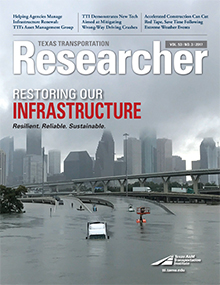
Hurricane Harvey’s impact on the Texas Gulf Coast was widespread and overwhelming. Thousands of survivors lost their homes and possessions. But everyone I saw interviewed was thankful for what they still had, especially their lives and loved ones.
If extreme weather events can have a silver lining, perhaps it’s to help us realize what really is important to us, what we tend to take for granted. Before Harvey, the greatest concern many Texans had about transportation infrastructure was how long they had to sit in bumper-to-bumper traffic. Following the hurricane, the precious commodity of accessibility — of victims to first responders and survivors to drinking water and shelter — made morning traffic jams seem like trivial things. Now, nearly two months later, the Texas Department of Transportation (TxDOT) is rebuilding the region’s transportation infrastructure and reconnecting communities along the coast. Those hit hardest by Harvey are likely seeing their local roadways in a whole new light of appreciation.

The Texas A&M Transportation Institute (TTI) has partnered with TxDOT for nearly 70 years to enhance the safety, mobility and reliability of the state’s transportation system. The trust and seamless interaction we’ve developed as partners were never more important than during Hurricane Harvey, when TTI personnel continuously updated Houston’s traffic management website, TranStar, accessed by over 1 million people and countless local and national news media during the event. Ensuring our infrastructure is as flexible and resilient as possible during extreme weather events must remain a priority moving forward.
Though I hope to see those flying cars from The Jetsons in my lifetime, it’s fair to say we’ll be utilizing surface transportation assets far into the future. Population growth will continue to expand urban communities, filling in the rural spaces between to form megaregions. In coming decades, city footprints will appear less like the signature skylines of Dallas and Houston and more like the nighttime images seen from space, where a whole region lights up the map well beyond the city limits sign.
As growth happens, we have two agendas related to infrastructure. To remain competitive in a global economy while improving safety and mobility at the local level, we have to refurbish crumbling assets built more than half a century ago. But for those facilities to meet our needs in the 21st century, we must incorporate advanced technologies such as connected and automated vehicles and smarter infrastructure to enhance connectivity between communities.
As we Texans do our part to rebuild our nation’s transportation infrastructure, it’s important to remember how vitally important that system of roads, airports, pipelines and ports is — to our daily lives as commuters, to the vitality of our economy in the international marketplace, and, most especially, to protecting our citizens during the worst of times. Working together to restore our Gulf Coast communities, let’s resolve to never take our transportation system for granted — and to better appreciate all it enables us to do for ourselves, our communities and one another.

